Public and Private Sectors Notes 8th Social Science
Public and Private Sectors Notes 8th Social Science
8th Social Science Lesson 23 Notes in English
23. Public and Private Sectors
Introduction
- India was basically an agrarian economy with a weak industrial base at the time of Independence.
- There were high level of poverty, illiteracy and unemployment in the country.
- India experienced very poor economic and social over heads. It is the principally for their reasons that the state had to play an extensive role in developing the country.
- Hence India conceived to have the Indian economy on socialist lines.
- The economic growth may be sustained at a maximum rate, if private sector and public sector join hands.
- India followed mixed economic system that it is operated both by private enterprises and public enterprises.
8th Social Book Back Questions
Public and Private Sector
- There are all kinds of business organizations – small or large, industrial or trading, private owned or government owned in our country.
- These organizations affect in our daily economic life and therefore become part of the Indian economy.
- Since the Indian economy consists of both private owned and government owned business enterprises, it is known as a mixed economy.
- The Government of India has opted for a mixed economy where both private and government enterprises are allowed to operate.
- The economy, therefore, may be classified into two sectors viz., private sector and public sector.
- The public sector and the private sector are allotted their respective roles in promoting the economic welfare of all sections of the community.
- Public sector industries are under its ownership of Government whereas the private sector industries are under the ownership of private people.
- The public sector enables the full growth in an economy. Public sector is on service motive and the private sector is on profit motive.
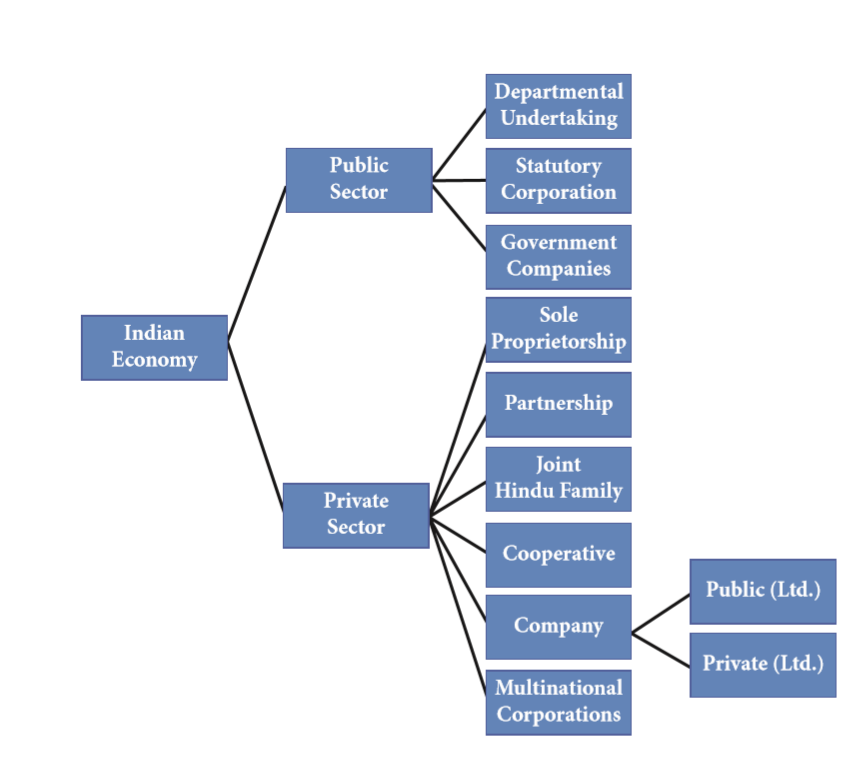
Definition of Public Sector
- The sector, which is engaged in the activities of providing government goods and services to the general public is known as Public Sector.
- The enterprises, agencies, and bodies are fully owned, controlled and run by the government whether it is central government, state government or a local government.
History of public Sector
- When India achieved independence in 1947, it was primarily an agricultural country with a weak industrial base.
- There were only eighteen Indian Ordnance Factories in the country which the British had established for their own economic interest and rule the subcontinent with brute force.
- The national consensus was in favour of rapid industrialisation of the economy which was seen as the key to economic development, improving living standards and economic sovereignty.
- Building upon the Bombay Plan (1940), which noted the requirement of government intervention and regulation, the first Industrial Policy Resolution announced in 1948 laid down broad contours of the strategy of industrial development.
- Subsequently, the Planning Commission was formed by a cabinet resolution in March 1950 and the Industrial Act was enacted in 1951 with the objective of empowering the government to take necessary steps to regulate industrial development.
- Prime Minister Jawaharlal Nehru promoted an economic policy based on import substitution industrialisation and advocated a mixed economic system.
- He believed that the establishment of basic and heavy industry was fundamental to the development and modernisation of the Indian economy.
- India’s second five year plan (1956–60) and the Industrial Policy Resolution of 1956 emphasised the development of public sector enterprises to meet Nehru’s national industrialisation policy.
- His vision was carried forward by Dr. V. Krishnamurthy known as the “Father of Public sector undertakings in India”.
- Indian statistician Prof. P.C. Mahalanobis was instrumental to its formulation, which was subsequently termed the Friedman– Mahalanobis model.
- The 1991 industrial policy was radically different from all the earlier policies where the government was deliberating disinvestment of public sector and allowing greater freedom to the private sector.
- At the same time, foreign direct investment was invited from business houses outside india.
- Thus, multinational corporations, which operate in more than one country gained entry into the Indian economy.
- Thus, we have public sector units, private sector enterprises and multinational corporations coexisting in the Indian economy.
The objectives of Public Sector
- To promote rapid economic development through creation and expansion of infrastructure
- To generate financial resources for development
- To promote redistribution of income and wealth
- To create employment opportunities
- To promote balanced regional growth
- To encourage the development of small-scale and ancillary industries
- To accelerate export promotion and import substitution.
Public Sector Organizations:
- There are two types of public sector organizations, i.e. either the Government fully finances them through the revenues they raise by collection taxes, duties, fees, etc. of the government holds more than 51% of the total share capital of the company which comes under various ministries.
- The enterprises are established with service motive. It is the largest sector, which works for the upliftment of the people by providing the following services to the people: Postal services , Railway services , Providing security, education and health facilities at low cost, and generation of employment opportunities, etc..
Organs of public sector:
1. Administration by a Government Department:
It is very common almost in all countries. Example – Post and Telegraph, Railways, Port Trust, Irrigation Projects on India etc.,
2. The Joint sector companies:
It is governed by a company law and controlled by the Government as principal major share holders. Example – Indian Oil Petronas pvt ltd, Indian Oil Sky tanking Limited. Ratnagiri Gas and Power Private Limited, Indian Synthetic Rubber Limited.
3. Public Corporation:
This type of organization is the establishment of public corporation by the state of the parliament of legislature. Example – LIC, Air India, The Reserve bank of India, Electricity Board.
Classification of Industries
- The public sector in India owes its origin in the 1956 Industrial policy resolution of the Government of India. This 1956 resolution classified industries into three categories. The Industries which would be exclusively owned by the state are referred to as Schedule-A
- The industries in which the private sector could supplement the efforts of the state sector, with the state taking the sole responsibility for starting new units which are specific in Schedule-B.
- The remaining industries which were in the private sector are mentioned in Schedule-C.
Public Sector is divided into the following nine categories
1) Public sector enterprises must supply essential infrastructure for economic development which are known as primary public utilities which include the following: Airlines, Shipping, Railways, Power Generation, Tele communication etc.
2) Public sector enterprises also to have control of the “commanding heights of the economy” e.g. Defence, Banks, Coalmines, Oil, Steel etc.
3) They are to play an entrepreneurial role which is, in other words, called capital intensive industries: e.g., Iron ore, PetroChemicals, Fertilizer, Mining, Ship – Building. Heavy Engineering etc.
4) Public sector enterprises under Government monopoly which includes: Telecommunication equipment. Defence production. Railways, Rolling Stock etc.
5) Public sector enterprises which are exclusively meant for High Technology industries, e.g.: Atomic energy.
6) Consumer oriented public sector undertakings. eg. Drug, Paper, Hotels etc.
7) Public Sector enterprise which is set up in order to take over the sick private units, e.g.: Textile, Engineering etc.
8) Public sector enterprises which are set up as Trade Corporation, e.g.: FCI, CCI etc.
9) Public sector enterprises which serves as a consultancy and engineering service etc. e.g. MECON.
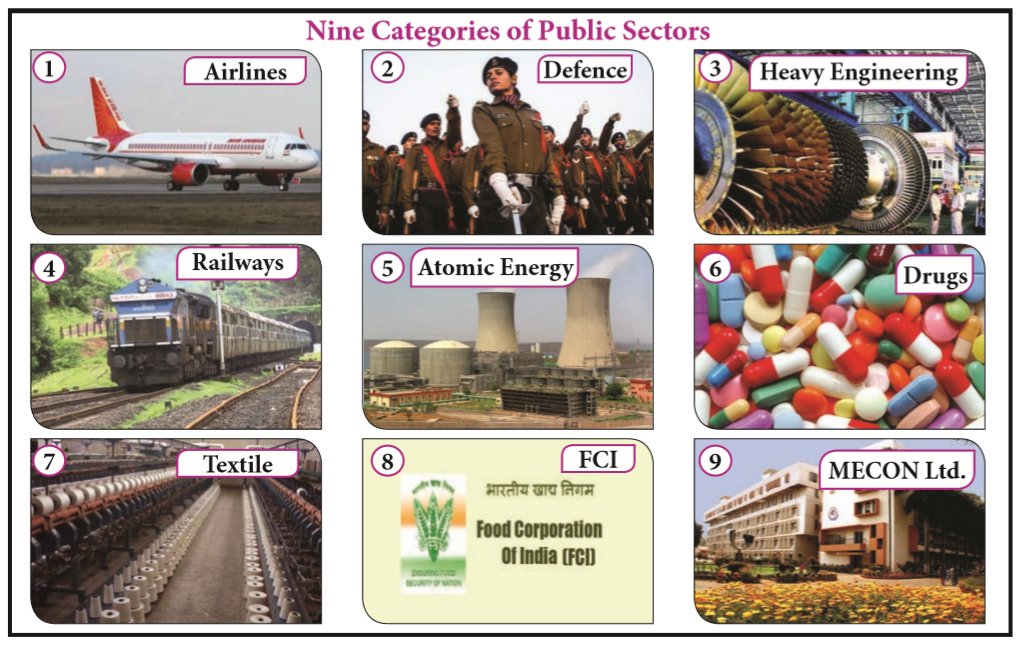
NITI Aayog (National Institution for Transforming India)
- NITI Aayog replaced 65 years old planning commission. Planning commission has power to allocate funds to ministries and states, this function will be now at finance ministry.
- NITI Aayog is a policy think tank and a truly advisory body formed on January 1, 2015.
Socio-Economic Development
- Socio-economic development is the process of social and economic development in a society. Socio-economic development is measured with indicators, such as GDP, life expectancy, literacy and levels of employment.
- The new “Think Tank” is NITI Aayog can form a suitable platform in integrating the social sector initiatives of the Centre, state and the local bodies.
Indicators of Socio Economic Development:
Gross Domestic Product (GDP)
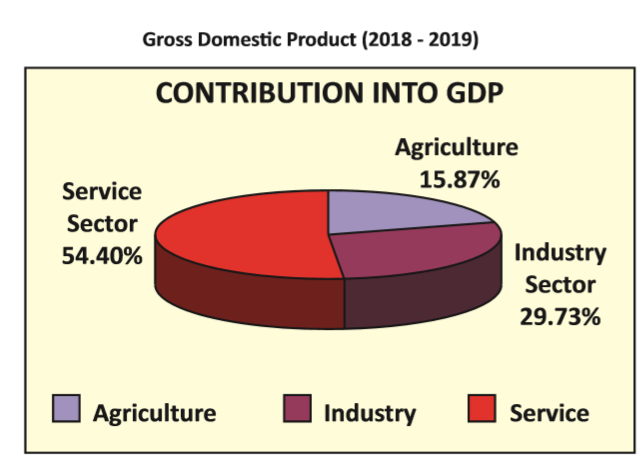
- GDP supports in developing socio – Economic Development. The proportion of GDP by the industrial sector both private and public sector has been increased.
- It results increasing government funds and increase public spending.
Life Expectancy
- According to 2011 Census of India, Life expectancy in India is 65.80 years for men and 68.33 years for women.
- Government provides high degree of health measures through various programmes.
- he Government announced in the Union Budget 2018-19 the “National Health Production Scheme” (NHPS) to serve poor and vulnerable families.
Literacy

- Educational skill plays a vital role in the Socio Economic Development. Sarva Siksha Abhiyan(SSA) is government of India’s flagship programme.
- It is implemented for making free and Compulsory Education to the children of 6-14 years with life skills.
- The Government also introduced RMSA, Smart class, e-learning, free computer skill classes and eco-friendly studying environment, Digital India for increasing the level of quality in education.
Employment
- There is a clear shift in employment to secondary and tertiary sector from the primary sector.
- A growing number of people moved urban areas in search of employment. It increased urban population, hence government started the ‘Smart city’ Scheme which provides the city with many facilities like hospitals, schools, housing facilities and shopping centers.
- To promote rural and backward areas in terms of employment the government encourages private sectors to start an industry in backward areas by providing tax benefit electricity at a lower tariff, etc., It removes regional inequality.
Provision of House, Clean Drinking Water and Sanitation
- Government sector provides housing facilities, clean drinking water facilities and sanitary facilities under clean India Planning.
- Providing clean water and sanitary facilities overcome diseases and malnutrition.
- By providing these facilities the Life Cycle of the people increases.
Importance of Public sector
Public sector plays a major role in the development of any economy. It has following importance:
1. Public Sector and Capital Formation: The role of public sector in collecting saving and investing them during the planning period has been very important.
2. Economic Development: Economic development mainly depends upon industrial development. Heavy & basic industries like iron & steel, shipping, mining, etc. are required for supplying raw materials to small industries.
3. Balanced Regional Development: Public sector undertakings have located their plants in backward parts of the county. These areas lacked basic industrial and civic facilities like electricity, water supply, township and manpower. Public enterprises have developed these facilities thereby bringing about complete transformation in the socioeconomic life of the people in these regions.
4. Employment Generation: Public sector has created millions of jobs to tackle the unemployment problem in the country. The number of persons employed during the year 2011 was 150 lakh. Public sector has also contributed a lot towards the improvement of working and living conditions of workers by serving as a model employer.
5. Export Promotion and Foreign Exchange Earnings: Some public enterprises have done much to promote India’s export. The State Trading Corporation (STC), the Minerals and Metals Trading Corporation (MMTC), Hindustan Steel Ltd., the Bharat Electronics Ltd., the Hindustan Machine Tools, etc., have done very well in export promotion.
6. Protection to Sick Industries: Public sector, to prevent sick unit closing down, takes over their responsibility & prevent many people from getting unemployed not only this but it prevents unnecessary locking of capital, land, building, machinery, etc.
7. Import Substitution: Some public sector enterprises were started specifically to produce goods which were formerly imported and thus to save foreign exchange. The Oil and Natural Gas Commission (ONGC), the Indian Oil Corporation Ltd., the Bharat Electronics Ltd., etc., have saved foreign exchange by way of import substitution.
Difference between Public sector and private sector
Though the public sector and private sector work together for developing the country they have different goals and motives. Here are some important differences between them.
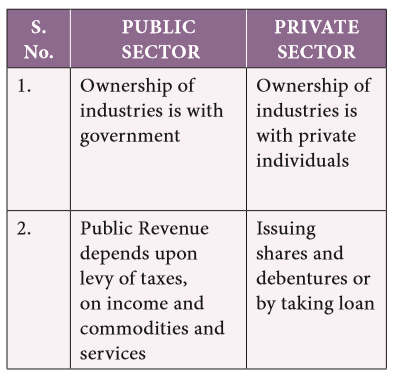
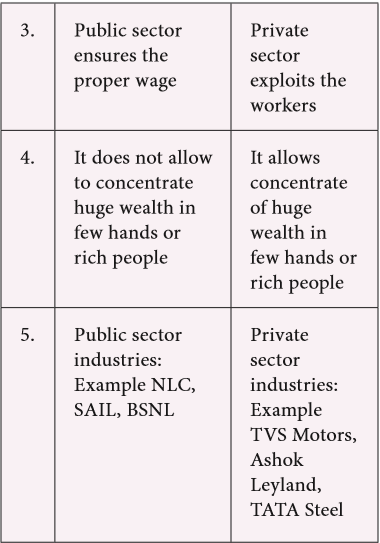
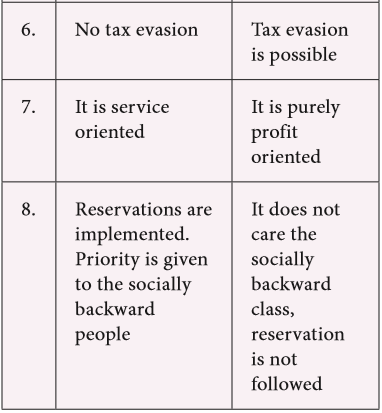
List of Public Sector undertaking industries:
In india, as for the year 2017 there are 8 Maharatna industries, 16 Navratna industries and 74 Miniratna industries. There are nearly 300 CPSEs (Central Public Sector enterprises) in total.
Maharatna Industries
Three years with an average annual net profi t of over ` 2500 crore, or Average annual Net worth of ` 10,000 crore for 3 years, or Average annual Turnover of ` 20,000 crore for 3 years (against ` 25,000 crore prescribed earlier) are called as Maharatna industries.
- National Thermal Power Corporation (NTPC)
- Oil and Natural Gas Commission (ONGC)
- Steel Authority of India Limited (SAIL)
- Bharat Heavy Electricals Limited (BHEL)
- Indian Oil Corporation Limited (IOCL)
- Coal India Limited (CIL)
- Gas Authority of India Limited (GAIL)
- Bharat Petroleum Corporation Limited (BPCL)
Navratna Industries
A score of 60 (out of 100), based on six parameters which include net profi t, net worth, total manpower cost, total cost of production, cost of services, PBDIT (Profi t Before Depreciation, Interest and Taxes), capital employed, etc., and a company must first be a Miniratna and have 4 independent directors on its board before it can be made a Navratna.
- Bharat Heavy Electronics Limited (BHEL)
- Container Corporation of India (CONCOR)
- Engineers India Limited (EIL)
- Hindustan India Limited (HAL)
- Hindustan Petroleum Corporation Ltd. (HPCL)
- Mahanagar Telephone Nigam Ltd (MTNL)
- National Aluminum company (NALCO)
- Neyveli Lignite Corporation India Ltd. (NLCIL)
- Oil India Ltd. (OIL)
- Shipping corporation of India (SCI)
Miniratna Industries – 1
Have made profits continuously for the last three years or earned a net profit of Rs. 30 crore or more in one of the three years. Some Miniratna Industries – 1 are
- Airports Authority of India (AAI)
- Bharat Dynamics Ltd.(BDL)
- Bharat Sanchar Nigam Ltd. (BSNL)
- Chennai petroleum Corporation Ltd. (CPCL)
- India Trade Promotion Organization (ITPO)
- State Trading Corporation of India (STCI)
Miniratna Industries – 2
Have made profits continuously for the last three years and should have a positive net worth. Some Miniratna Industries – 2 are
- HMT (International) Limited
- Indian Medicines & Pharmaceuticals Corporation Limited
- MECON Limited
- Mineral Exploration Corporation Limited
- National Film Development Corporation Limited
- Bharat Pumps & Compressors Limited
Definition of Private sector
- The segment of a national economy that is owned, controlled and managed by private individuals or enterprises is known as Private sector.
- The private sector companies are divided on the basis of sizes which are privately or publicly traded organizations.
- They can be created in two ways, i.e. either by the formation of a new enterprise or by the privatization of any public sector enterprise.
- The Private sector is a part of country’s economic system that is run by individuals and companies, rather than the government.
- Even the vast expansion of public sector, the contribution of the private sector continued to be very large.
- This was due to the development of medium, small and very small or micro industries. Also, the contribution of the products of cottage, and village industries and the small, scale industries is the major portion of the wholesale and retail trade.
- The contribution of private sector towards national production is higher than the public sector, Private sector is dominent in road, ship, and airways transport and also in consumer industries.
Major private companies
- Infosys
- Aditya Birla Company
- Reliance Industrial companies
- Tata Group of companies
- WIPRO Limited
- Hindustan Unilever Limited
- ICICI Bank Limited
Functions of Private Sector
- The main function of private sector is to create innovation and modernization. The profit motive drives them to invent, innovate new techniques of production and manage the productive activities in a scientific manner.
- Develop and maintain infrastructure and services.
- Promote and expand existing businesses.
- Promote human capital development, to help vulnerable groups especially to participate in the labour market and encourage community development by promoting community business and co-operatives, local exchange systems and informal credit etc.
- Promote small, micro and medium enterprises (SMME) through supply side measures and demand side measures and attract investment in the city.
- In India, being a mixed economy, has assigned a great importance on the private sector of the country for attaining rapid economic development.
- The Government has fixed a specific role to the private sector in the field of industries, trade and services sector.
- The most dominant sector of India, i.e., agriculture and other allied activities like dairying, animal husbandry, poultry etc. is totally under the control of the private sector.
- Thus private sector is playing an important role in managing the entire agricultural sector and thereby providing the entire food supply to the millions.
- Moreover, the major portion of the industrial sector engaged in the non-strategic and light areas, producing various consumer goods both durables and non-durables, electronics and electrical goods, automobiles, textiles, chemicals, food products, light engineering goods etc., is also under the control of the private sector.
- The social and economic challenges before the country are great. To meet the targets in structural transformation and economic growth public sector and private sector must join together.
More to Know:
1. The term Navaratna meant a talisman composed of nine precious gems. Later, this term was adopted in the courts of Gupta emperor Vikramaditya and Mughal emperor Akbar, as the collective name for nine extraordinary courtiers at their respective courts.
2. The largest public sector employer in india is Indian Railways.
3. Mixed economy is the mixture of merits of both capitalism and socialism.